Several years ago I read an article that noted the decline in children’s ability to crawl. In the report, pediatricians said perhaps they had overstated the importance of crawling, and it was a developmental milestone that could be jettisoned from the books. NOOOOOOOOO!!!!
Crawling is really important. When physical therapists and I sat at child study meetings and the parents would boast that the child was a precocious walker, “…even skipped crawling…” the other therapists and I would give each other sidelong glances in dismay. When children skip crawling, they miss MANY important opportunities to develop motor control. When you look at the lengthy list of benefits below you will understand why crawling is critical to a child’s early and life long development.
Benefits:
- Trunk strengthening-especially the back and neck muscles.
- Dynamic balancing-lifting and placing hands while legs move requires the shifting of the center of gravity four different times-that is a lot of adjusting for the little body to do. When the baby reaches for a toy, even more balancing is required.
- Arms and legs are working simultaneously, leading to the development of bilateral motor coordination.
- The arms and legs follow a pattern,establishing the foundation for motor sequencing.
- Weight bearing into the hands increases hand and finger strength, critical for fine motor skills, eventual drawing and writing ability.
- Crawling is “Heavy Work” thereby stimulating the proprioceptors and activating the filtering and organizing centers in the brain. This improves attention-long term!
- When toddlers are just learning to walk, it is the safe and more efficient way to get around.
- For older children learning to sit for longer periods at a desk, it provides a welcome break that reenergizes the body and mind.
- When grown-ups get down on the floor to play with children, it brings them “to the child’s level” thus allowing the adult to “join the child.” The ensuing interactions is more positive and intense.
Special Considerations:
Some children struggle with crawling. They may substitute scooting on their bellies, or doing a sit slide. These are all good precursors to crawling. Below are guidelines to help little ones overcome the hurdles for crawling.
Remember to always model crawling. Get down on the floor and crawl around with your child. You’ll both have more fun and you’ll get a work out too!
Final Thoughts:
If you’ve ever taken an exercise class for core strengthening, a challenge exercise you may have tried is to assume four point (crawling position) and then reach forward with one arm while the opposite leg extends. Try it! Then you’ll appreciate how fabulous crawling is for children of all ages!
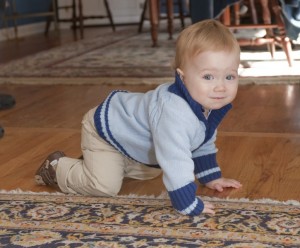
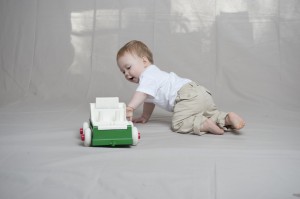
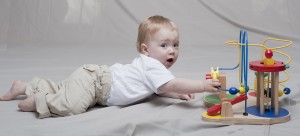
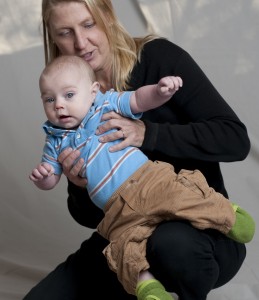
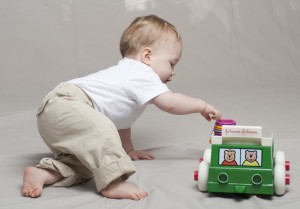
Hi Jill,
My baby Girl is a preterm of 7 months and was weighing 750gm at birth.. I had severe Pre-eclampsia and we had do an emergency C Section…
Now my baby after 8 months is weighing 5.7 kg and struggling to crawl.. she scooting her belly.. How can i improve her crawling ability? Is her low weight acting as a hindrance for crawling..
Will Appreciate a Reply asap…
Scooting is great…Try lots of tummy time and encourage reaching. Take it slow-she still has a lot of catching up to do!
I take care of a 12 months boy who is very “stiff” , he can’t bend his knees, fall back “like a stick” on his head when he looses stability, doesn’t crawl. He just turn from back to belly last week. He can sit slide and wants to walk by himself. I’m looking for gross motor skills exercises to help him move when on his belly and to teach him to fall on his bottom instead of on his head. His mother made him use a lot of baby gear like a walking saucer and force sitting at a very young age. Is there a way I can help him in my daycare? Is the scooter board a great option? The exercise ball? I do a lot of tummy time, that he hates.
Great that you encourage tummy time! Keep it up & encourage reaching for toys. Belly crawling is a good start and rolling is great too. Maybe time for Birth to 3 (Early Intervention) to take a look?
Thank you so much in advance for your time and response!
Jill,
I have an 11 month old baby who is comfortable sitting up but she can’t get there on her own, so if I sit her up, she wont be able to move or go anywhere. When she lays down in her belly she moves transitioning from back to belly and back again, kind of a rolling motion but very slow, I try to encourage her to spend a lot of time in the floor in a safe space with toys at a reasonable distance. She does not crawl or scoot yet. She is reaching and then gets frustrated. I wanted to respect her own pace and to figure out transitions herself. I have an older son who took his time too, now he is 3 and running and jumping. I dont know if I should be worried or if I should be doing anything to encourage her to move more and what to do. Sometimes I think is a matter of time and opportunities and other times I doubt. I just want to provide her with the tools she needs in order for her to feel comfortable and confident with her body.
Any recommendations?
Best,
Karen
Hi Karen,
It sounds like you’re doing a lot of great things…encouraging reaching, changing positions. Try providing a little extra support to get started if your little girl seems stuck. Gentle blanket roll-ups(a blog post) might be fun on a very soft surface to help her get moving. You mentioned that your son took his time…if this feels the same don’t worry and just encourage lots of motor play. If it feels different you might want to ask your pediatrician for a referral to an early intervention team in your area. This is one of the few “free” things in the US that can be extra-ordinarily helpful…either allaying fears and validating that all is on track, or facilitate any additional support that might help your daughter move forward.